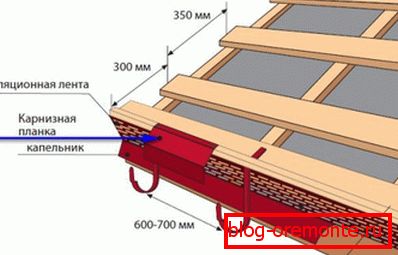Wind strip for metal tiles - types and installation
A roof covered with modern metal tile is a practical solution for a private cottage, country house or townhouse. Contrary to the convictions of homeowners, the durability of such a roof does not fully depend on the quality of the roofing material. A great influence on the durability, water resistance, reliability have additional elements used for installation, despite the fact that their area is less than 5% of the roof surface. In this article we will describe what a wind strip is for a metal tile, what it is for, and also how it is fixed.
Species
Wind strip - one of the additional elements used for the roofing of metal roofing. It is a corner of plastic or galvanized metal and performs protective and decorative functions. The following types of wind strips are distinguished:
- Eaves. This plank is installed on the board, which is called the frontal, to protect against water, cold air. The metal tile, laid on the crate, forms a small overhang through which atmospheric moisture or condensate penetrates into the roof truss system. To prevent damping, moldy wooden frame elements, perform the installation of the cornice strip.

- Face. The end plate is used to protect the lateral end surfaces of the roof of metal from atmospheric moisture, wind, condensate. From the eaves, the end plate differs only in the place of installation.

Important! The wind strip is a corner with 2 mounting shelves, the wider they are, the more reliable this additional element for the roof protects the overhang from moisture and wind penetration. Installation of the end element is often performed in conjunction with seals, repeating the shape of the coating waves, for more efficient operation.
Materials, sizes
For the manufacture of wind eaves using material with high resistance to atmospheric phenomena, as well as mechanical strength. The term of operation of the roof of metal is not less than 20-25 years, which means that the additional elements should serve no less. The following strips are most often used:
- Steel. The most popular models of additional elements to protect the ends and ledges are steel. Galvanized steel, which is coated with a layer of paint, pural or polyester during the manufacturing process, withstands the effects of water, does not corrode, and it is fairly light and durable.
- Plastic. Polyvinyl chloride is a thermoplastic plastic used to make a curtain rod and end strip. The advantages of this material - light weight and a variety of colors. However, the plastic elements are subject to thermal expansion, in addition, they are not recommended to install the heat cable for heating the roof.

Consider that the sizes of models of a cornice strip for metal tiles are very different. This additional element usually has a length of 1.5-2.5 m, the width of the mounting shelves is 15-30 cm. Steel products are made to order by the size of the buyer.
Functions
Additional elements in the composition of the roof of metal, depending on the complexity of the design, make up 2-5% of the area, but their value can not be overestimated. Installation of roofing without wind strips leads to the penetration of moisture and wind into the roof frame and, consequently, accelerated wear of the material. Curtain and wind strip perform the following functions:
- Protective. The main task of the ledge is to prevent the penetration of atmospheric moisture and cold wind under the roofing material. Due to the high humidity, the wooden frame dampens and rots, which negatively affects the lifetime of the roof. Blowing cold air into the attic room increases the cost of heating the house.
- Decorative. Installation of wind slats allows you to carefully sheathe the frontal plank and aesthetically, as well as hide the “insides” of the truss system from the eyes. Additional elements are selected in tune to the color of the metal tile, so the slopes look holistic and harmonious.
Skilled craftsmen claim that additional elements for metal tiles can be made by hand. Wind strips are made of sheet metal with a thickness of 0.4-0.5 mm. However, the improvised slats will not look so neat.
Installation
Wind slats are simple in design, so models from different manufacturers differ only in the type of coating and the thickness of the metal used. The performance of these devices depends on the correct application. Installation of eaves and end slats is as follows:
- Eaves levels are fixed on the eaves board to the flooring of the roofing material. Before installing this additional element on the eaves fix brackets for the gutter. After that, the wind bar with an overlap of 10-15 cm is fixed on the cornice using nails or screws with a step of 30-50 cm.
- Wind slats are fixed on the frontal board after the roofing of the metal tile. They should cover the roofing material on 1 wave. The overlap between these elements can be more than 50 cm. Each plank is fixed to the board with 4 nails or screws to avoid deformations in a strong wind.

Important! The joints between the wind slats must be tight and not water. To do this, they are treated with a silicone-based sealant.